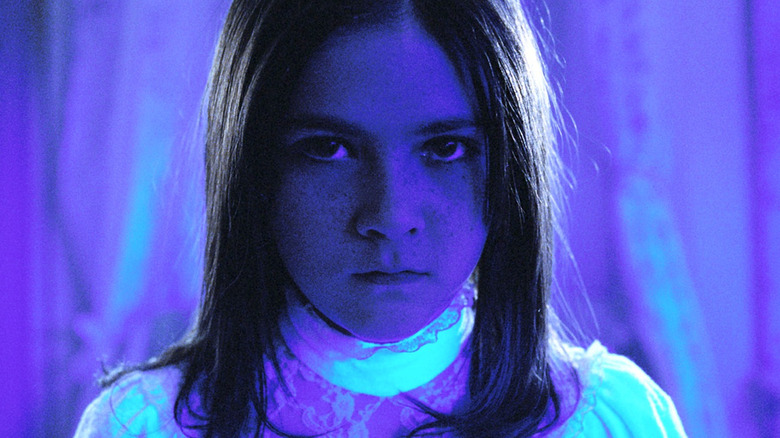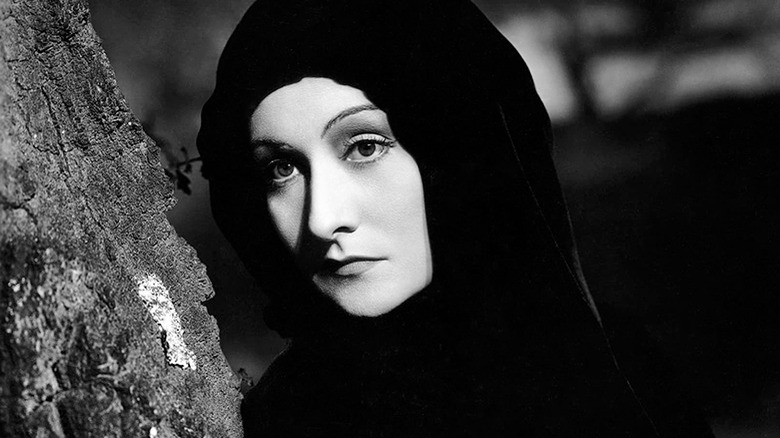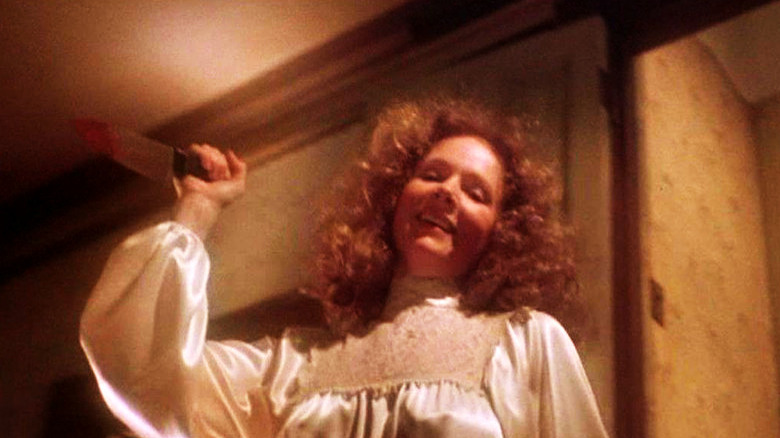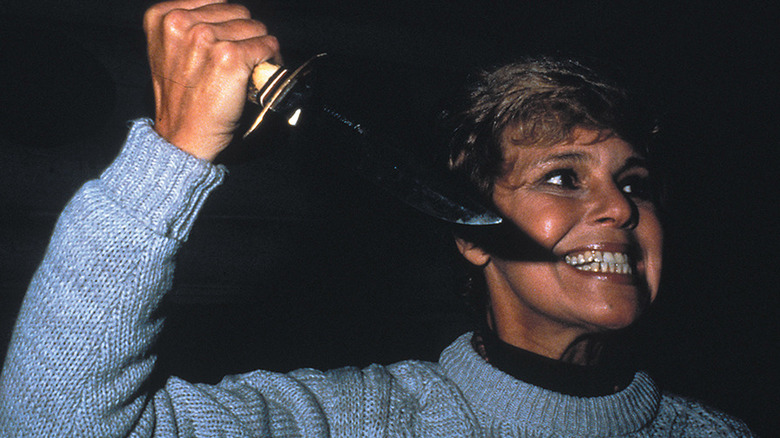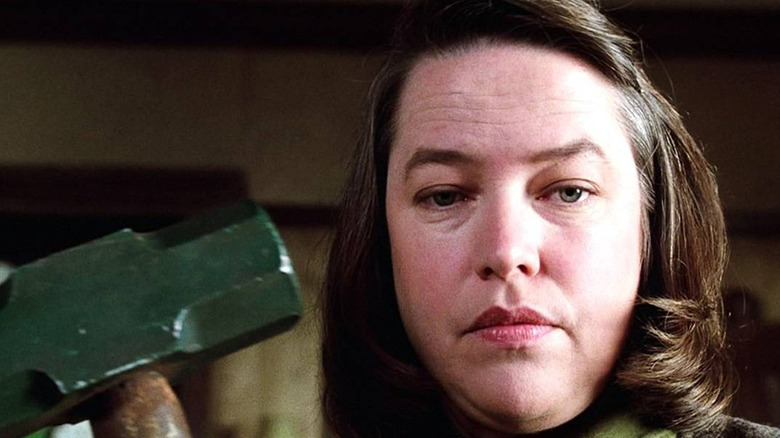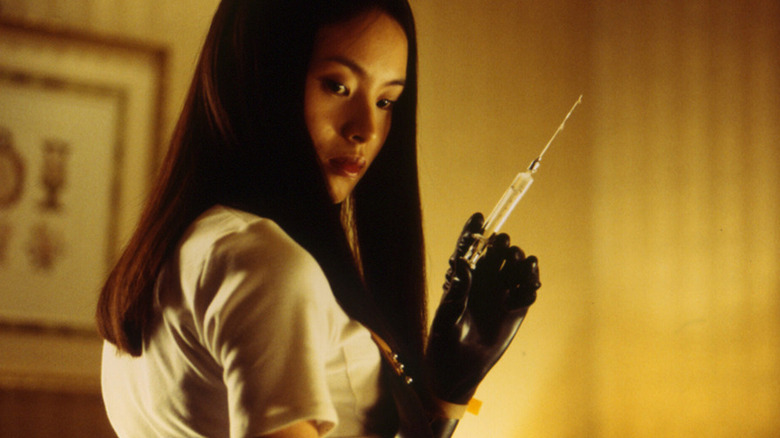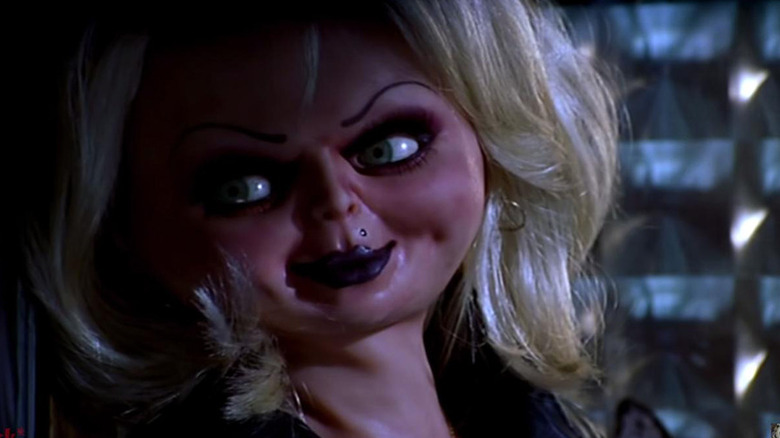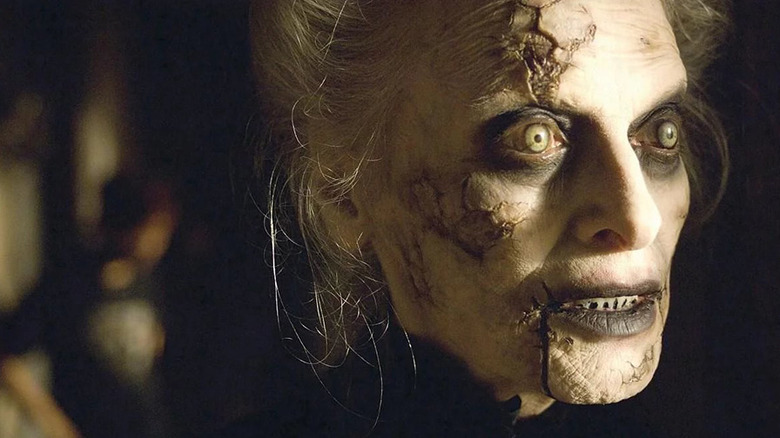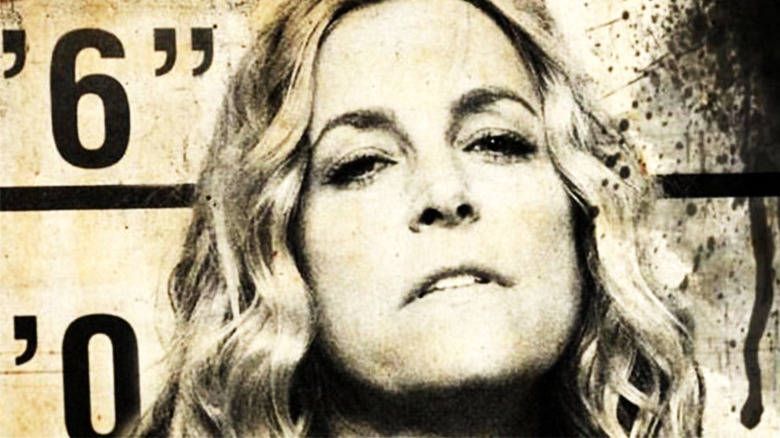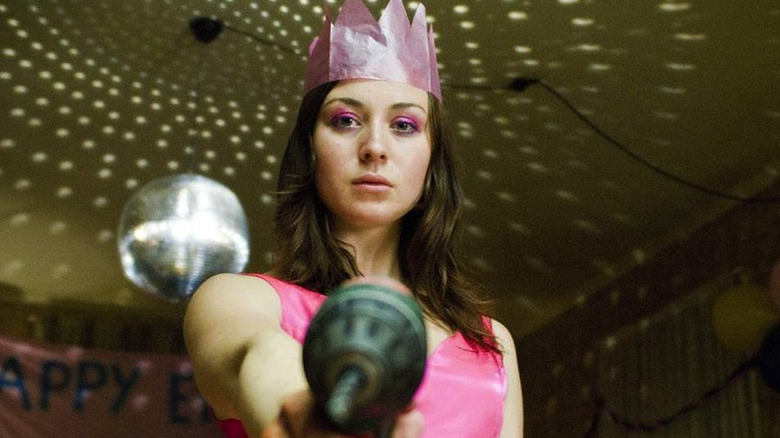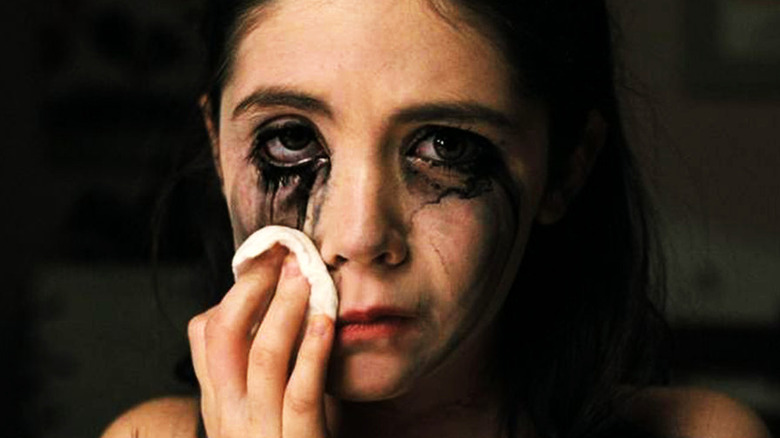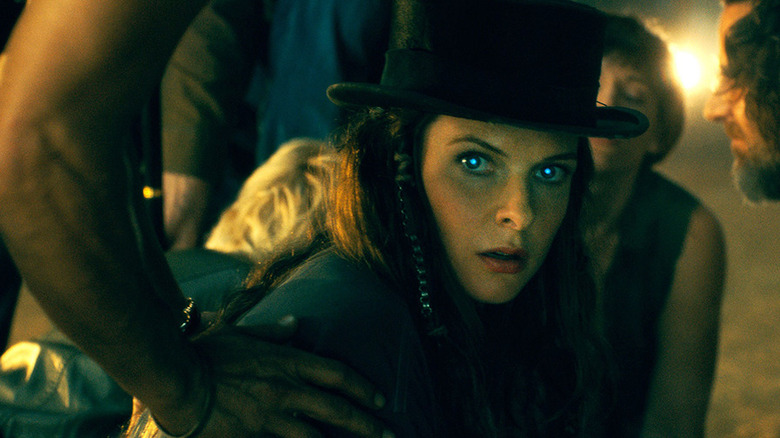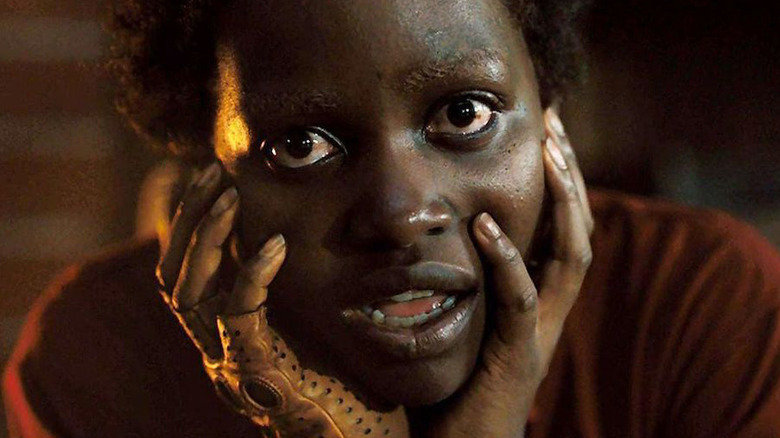The Scariest Female Horror Villains
Horror, despite frequent victimization and exploitation of women, is often referred to as a very feminist genre. The genre has often been a great space for more female-centric and female-helmed works to get mainstream attention. One need only look at films like "The Babadook" and "Ginger Snaps" to see narratives built around intriguing female protagonists. Additionally, many quality entries in the genre have been the brainchilds of various female talents. "American Psycho," often regarded as a top-tier entry in horror, was directed by the talented Mary Harron.
Additionally, there is the final girl trope, where the surviving character in the film is often female. This can be seen in such movies as "Halloween," "A Nightmare on Elm Street" and "Alien," just to name a few. However, horror proves itself most as a feminist venue when it allows women to be the ones holding the chainsaws. There have been countless male horror villains, so it's more than appropriate to showcase the scariest women in horror. Whether they be young or old, supernatural or just mentally deranged, these are the women who made us keep our lights on at night!
Countess Marya Zaleska (Dracula's Daughter)
If we're going to talk about horror cinema's scariest female villains then we need to travel back to 1936. "Dracula's Daughter" was an early release in the now legendary and influential Universal Pictures horror cycle. From the '30s to the late '50s, film's greatest monsters, such as Frankenstein, the Wolf-Man and Dracula would make their mark.
The film focuses on Countess Marya Zaleska (Gloria Holden) looking to free herself from the vampiric affliction handed down by her father. After his demise fails to lift the curse, she turns to Dr. Grant for help but ends up kidnapping his fiancee, Janet. Holden is in top form in this film, bringing a stoic but also seductive quality to the role as well. The film has received much reevaluation in the decades since its release for very interesting reasons. "Dracula's Daughter" has been decided upon as the genesis for the lesbian vampire trope common now in fictional media. The film, despite being made in the 1930s, does hint at Zaleska's lesbianism through her actions towards Janet. The studio even used this to grab moviegoers' attention with taglines like "Save the women of London from Dracula's Daughter!"
Dracula's daughter, for her foreboding visage and progressive sexuality, is an important character and milestone in the horror evolution.
Margaret White (Carrie)
Parents play such a pivotal role in our lives, so it's important they provide their children with a healthy amount of stability. Sadly, that is certainly not the case for young Carrie White in the 1976 film adaptation of Stephen King's novel. Carrie (Sissy Spacek) is the victim of much cruelty at school, due in part to her fanatically religious mother.
Margaret White (Piper Laurie) puts the lord before anything else, especially her daughter, whose adolescent changes only exacerbate the issue. After being informed of Carrie's unfortunate incident in the girl's showers, she proceeds to demean Carrie both verbally and physically. She refers to Carrie's newly developed breasts as dirty pillows, which is only the tip of the iceberg. The most disturbing act of all, she locks Carrie in a makeshift prayer closet to pray away her sin. Her cruelty only intensifies as she attempts to stop Carrie from attending prom, stating that everyone will laugh at her.
The elder White eventually meets her end when, after an attempted stabbing, Carrie snaps and kills her with her telekinesis. Margaret is often referred to as the true villain of "Carrie," and it's not an unfair assessment. Carrie, despite her now infamous actions during the prom night scene, truly is a victim throughout most of the film. Margaret White would be the first of many psychotic female villains in Stephen King's works.
Pamela Voorhees (Friday the 13th)
They say a boy is nothing without his mother, and in the case of Jason Voorhees, that couldn't be more true.
One of the most popular misconceptions in all of pop culture is that Jason Voorhees has always been the antagonist in "Friday the 13th." While Jason is synonymous with the series, it was actually his mother, Pamela, holding the knife in the series' first outing. The first film, especially compared to later entries, is a noticeably moodier and slower-paced film. Additionally, unlike later entries where Jason was on full display, the film doesn't reveal the killer's identity until the final scenes.
Betsy Palmer infamously only took the role because she needed the money to afford a new car. She even went as far to call the film's script "...a piece of sh*t!" and hoped no one would see the film. Despite those less than enthusiastic circumstances, Palmer doesn't phone in her performance in the slightest. Instead of simply being a seemingly kind, middle-aged woman in a blue sweater, Palmer also manages to bring menace to the role. She perfectly played a deranged mother seeking vengeance on the Crystal Lake counselors after they failed to stop Jason from drowning. It's a performance still highly regarded within horror cinema and the catalyst for the rest of the series. Her beheading at the film's climax opened the door for Jason to become the killer in the followup and each film to follow.
Annie Wilkes (Misery)
"Misery" is regarded as one of the best adaptations of Stephen King's work, and it's not hard to see why. Not only is it impeccably directed by the great Rob Reiner, but it contains one of Kathy Bates' best performances.
After saving writer Paul Sheldon from an accident, Annie Wilkes initially comes off as a kind, if not mildly eccentric, woman who introduces herself to Paul as an extremely enthusiastic fan of his book series, which centers on a character named Misery. But as the days go on, Annie, enraged at Paul killing off Misery, reveals her psychotic tendencies. This leads to Annie both mentally and physically abusing Paul as she forces him to rewrite the book. Annie's perfectionist demands and overbearing meddling disrupts Paul's creative process. The concept of the psychotic fan is a disturbing recurring trope that has basis in real life. It is a common occurrence for celebrities of varying types to be harassed by overly obsessed fans of their work.
Bates portrays that mentality with ample gusto, balancing both disturbing cheerfulness and bloodthirsty rage. It was no surprise then when, at the subsequent 63rd Academy Awards, Bates took home an Oscar for Actress in a Leading Role.
Asami Yamazaki (Audition)
Sometimes it really is the quiet ones you have to worry about. Takashi Miike's cinematic offerings have a recurring motif of gleeful sadism, and "Audition" is the perfect example of it.
Shigeharu Aoyama (Ryo Ishibashi), a recent widower, is convinced by his producer friend to use a faux audition to find the perfect woman. After much trial and error, Shigeharu is eventually smitten with the soulful Asami Yamazaki (Eihi Shiina). Asami, much like the film itself, lures you into a false sense of security with her earnestness and soulful demeanor. But after a while, it becomes clear Asami is harboring some dark secrets that Shigeharu begins to uncover.
Any man who Asami has affiliated with has either gone missing or has left evidence behind of being mutilated. The whole film is an expertly paced slow burn that slowly but surely ratchets up the tension until the climax — a climax containing one of the most drawn out and unrelenting torture sequences in all of horror cinema. Asami's demeanor during this sequence completely drives home her obsession and bubbly sadism. This is helped by sickening descriptions of her torture apparatuses as well as her repetition of certain words. Shiina's performance is the true standout in the film, and is still regarded as one of horror's finest.
Tiffany Valentine (Bride of Chucky)
Behind every psychotic serial killing doll there is an equally psychotic serial killing woman! In the case of Charles Lee Ray, AKA Chucky (Brad Dorif), that would be Tiffany Valentine (Jennifer Tilly), first introduced in "Bride of Chucky."
Retroactively created as Chucky's equally bloodthirsty girlfriend, Tiffany succeeds at resurrecting him after his gruesome demise in "Child's Play 3." What begins as a joyous, if not bloody reunion quickly goes south as Chucky reveals his dismissive feelings towards Tiffany. This results in next level relationship issues as Chucky electrocutes Tiffany in her own bathtub. Then, as a spiteful act, he utilizes the series' recurring voodoo curse to trap Tiffany's soul in another doll.
This results in the plastic duo conniving a young couple, Jesse and Jade, into transporting them to New Jersey. Along the way, Chucky and Tiffany spill a fair amount of blood and rekindle their undoubtedly twisted but endearing romance. This results in one of cinema's strangest and most offbeat love scenes as the two dolls consummate their relationship. Sadly, the honeymoon stage doesn't last long, which results in both of them meeting their respective, if not temporary, ends.
Tiffany would be received very well by "Child's Play" fans to the point she was brought back for three sequels. Just goes to show that behind every great man is a woman... or, in this case, another killer doll.
Mary Shaw (Dead Silence)
Beware the stare of Mary Shaw. She had no children, only dolls. And if you see her in your dreams, be sure you never, ever scream. Whether it's Billy from "Saw" or Annabelle from "The Conjuring," James Wan clearly has a fascination with dolls and puppets. But the precedent for this recurring trend in his work was set back in his third theatrical release "Dead Silence," which wasn't as well received as his other projects.
The film concerns Jamie Ashen (Ryan Kwanten) who, after the death of his wife, returns to his hometown for answers — answers concerning a mysterious ventriloquist doll and the infamous local legend about a woman known as Mary Shaw (Judith Roberts). Mary was a renowned ventriloquist who didn't take kindly to a rude child saying he could see her lips moving. When the child mysteriously went missing, the townspeople hunted down Mary and lynched her. However, Mary's final wish was, fittingly, to be turned into a dummy and buried with her dolls. Now in a new ghostly form, complete with soulless eyes and ventriloquist doll mouth, she seeks vengeance on Jamie's bloodline.
Mary kills several people throughout the film by ripping their tongues out, leaving them with horrific doll-like gaping maws. Her design, as previously mentioned, can be described as a disturbing human and ventriloquist doll hybrid. With an unsettling backstory and a haunting appearance, Mary Shaw will have you screaming until your final breath.
Baby Firefly (Firefly Trilogy)
Gimme a B. Gimme an A. Gimme a B. Gimme a Y. What's that spell? Baby!
Baby (Sherri Moon Zombie) is the female sibling of the disturbing backwoods serial killer cult gang known as The Fireflies. Flanked by the likes of Otis (Bill Moseley) and Captain Spaulding (Sid Haag), it's quite impressive that Baby stands out as the craziest. Baby, first introduced in "House of 1000 Corpses," is a Hollywood-obsessed and overly bubbly serial killer, carrying out all of her family's heinous deeds with a smile and a disturbing song on her lips. The song is quite literal as she serenades her soon-to-be victims with "I Wanna be Loved By You" by Helen Kane. Moon Zombie has a clear appreciation and understanding of the role, having played it three times from 2003 to 2019.
Over the course of the following films, "The Devil's Rejects" and "3 From Hell," Baby's insanity would only increase. Despite her bloodthirsty and cruel nature, Baby still maintains a strangely endearing charm, a recurring theme in Rob Zombie's work. This is best illustrated by a delightful scene where Baby and Spaulding pester Otis into stopping for ice cream. Baby, despite being a bloodcrazed psychopath, does have a lot of affection and appreciation for her entire family.
Lola (The Loved Ones)
"The Loved Ones" is often regarded as an underrated gem from the past 15 years of horror cinema. The film centers around a high schooler named Brett who ends up in the crosshairs of his demented classmate, Lola. After declining her offer to go to prom, Brett, still coping with his father's death, is kidnapped by her. He is then forced into a disturbing mock prom by Lola and her father whilst he is mentally and physically abused.
Lola, played by Robin McLeavy, completely steals the show. Her performance rides the fine line between disturbing and campy, but never once does McLeavy go too over the top. Lola at no point in the film sees anything wrong with what she's doing to Brett. She just views the situation, in her demented mind, as the perfect prom night with the cutest guy in school. This delusion is aided by her equally insane and uncomfortably close father, who helps her with this sickening act. The scale of Lola and her father's crimes is only increased throughout the film, which takes several twists and turns.
The true terror of Lola is that throughout the entire movie, she could do anything at any moment. She goes from playfully trying to feed Brett in one scene to threatening to horrifically mutilate him in the next. It's a performance that deserves far more attention as it and the film are both superb.
Esther (Orphan)
Orphan has gained much more praise and attention in the years following its release than it initially did in 2009. This is due to many things, but the most notable would be its uncanny and disturbing similarity to a real life news story.
After an unfortunate stillbirth, Kate and John Coleman (Vera Farmiga and Peter Sarsgaard) look to aid their strained marriage by adopting a third child. They are both immediately drawn to a young Russian girl named Esther (Isabelle Fuhrman) and adopt her. Things start to turn sinister as Esther is quick to injure a school bully and even hurt a small bird. Her transgressions evolve quickly as she begins to reveal her sadistic nature. Her evil doesn't stop there as her ultimate goal seems to remove her adopted mother from the picture.
It is eventually discovered that Esther has no documented records and a history of people around her ending up dead. That is, however, upstaged by the bigger twist of Esther actually being a mentally disturbed 33-year-old woman with hypopituitarism. Even back during the film's original release, Fuhrman received much praise for her disturbing portrayal of Esther. It's no surprise then that Fuhrman will reprise the role in an upcoming prequel film nearly a decade later.
Rose the Hat (Doctor Sleep)
Stephen King seems to have a knack for creating memorable female antagonists. "Doctor Sleep," the sequel to "The Shining," picks up 30 years after Danny Torrance experienced the horrors of the Overlook Hotel. As Danny (Ewan McGregor) copes with both his sobriety and his shining ability, a new threat looms. It's revealed that people with the shining have become victims to a vampiric cult known as the True Knot. The cult, led by Rose the Hat (Rebecca Ferguson), maintains immortality by consuming the essence of shining users.
The film centers on Danny fighting to protect a young girl named Abra (Kyliegh Curran) and her gift from Rose. Despite being the leader of a vicious group of vampiric monsters, Rose is not a one-note villain. She legitimately cares for her clan and is heartbroken when one of their immortalities finally expires. However, the film never lets you forget just how cruel and sadistic Rose actually is at her core. The most horrific example being a scene when Rose and True Knot kill a young boy for his essence. She explains that the essence grows stale as people age, which is why her clan targets children.
Ferguson received much praise for her portrayal of Rose the Hat, injecting the role with equal parts malice and charisma.
Red (Us)
Red, from director Jordan Peele's sophomore cinematic release "Us," is a unique outlier amongst female horror villains. This is due to both her utterly bizarre backstory and for being one of the more prominent African-American antagonists of the modern era.
"Us" is the story of the Wilson family, menaced by their horrific doppelgangers while on vacation. The mother, Adelaide, portrayed by Lupita Nyong'o, is on edge almost immediately due to their trip, thanks to an incident in her childhood where she claims to have seen her doppelganger in a funhouse. The family's doppelgangers, known as The Tethered, quickly make their presence known, attacking the Wilsons at the command of Red.
Red, Adelaide's Tethered, quickly makes her intentions clear as she regales the terrified Wilsons with a horrific monologue. Whenever on screen, Red speaks in a horrifically dry and almost withered voice, which only serves to heighten her menace. Add to that her thousand-yard stare and haggard appearance and it's impossible to not be creeped out by her. It is eventually revealed that Adelaide herself is the true Tethered version, having snatched and swapped places with her double during their childhood encounter. Nyong'o's double performance truly is an impressive feat, and it's still disappointing to many that she was not nominated for an Oscar.
